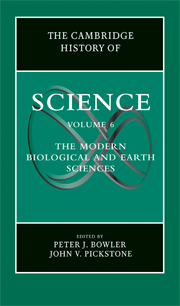Book contents
- Frontmatter
- 1 Introduction
- PART I WORKERS AND PLACES
- PART II ANALYSIS AND EXPERIMENTATION
- 10 Geology
- 11 Paleontology
- 12 Zoology
- 13 Botany
- 14 Evolution
- 15 Anatomy, Histology, and Cytology
- 16 Embryology
- 17 Microbiology
- 18 Physiology
- 19 Pathology
- PART III NEW OBJECTS AND IDEAS
- PART IV SCIENCE AND CULTURE
- Index
- References
15 - Anatomy, Histology, and Cytology
from PART II - ANALYSIS AND EXPERIMENTATION
Published online by Cambridge University Press: 28 November 2009
- Frontmatter
- 1 Introduction
- PART I WORKERS AND PLACES
- PART II ANALYSIS AND EXPERIMENTATION
- 10 Geology
- 11 Paleontology
- 12 Zoology
- 13 Botany
- 14 Evolution
- 15 Anatomy, Histology, and Cytology
- 16 Embryology
- 17 Microbiology
- 18 Physiology
- 19 Pathology
- PART III NEW OBJECTS AND IDEAS
- PART IV SCIENCE AND CULTURE
- Index
- References
Summary
It is as though, when we look at the living body, we look at its reflection in an ever-running stream of water. The material substratum of the reflection, the water, is continually changing, but the reflection remains apparently static. If this analogy contains an element of truth, if, that is to say, we are justified in regarding the living body as a sort of reflection in a stream of material substance which continually passes through it, we are faced with the profound question – what is it that actually determines the ‘reflection’? Here we approach one of the most fundamental riddles of biology – the ‘riddle of form’ as it has been called, the solution of which is still entirely obscure. Wilfred E. Le Gros Clark, The Tissues of the Human Body, 6th edition (Oxford: Clarendon Press, 1971), p. 9
Anatomy, histology, and cytology are sciences of form that have largely depended on the study of the dead: dead bodies, dead tissues, and dead cells. Each science began with observers isolating, identifying, and naming the external and internal structures of living things, first with the naked eye and then with microscopes. For some investigators, the primary goal has been classification, arranging the bewildering array of plants, insects, fish, birds, and animals into groups and subgroups based on the shapes and arrangements of their parts.
- Type
- Chapter
- Information
- The Cambridge History of Science , pp. 265 - 284Publisher: Cambridge University PressPrint publication year: 2009
References
- 2
- Cited by



